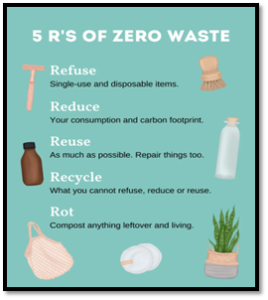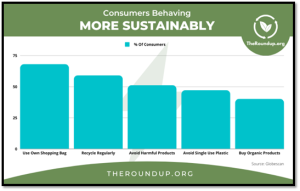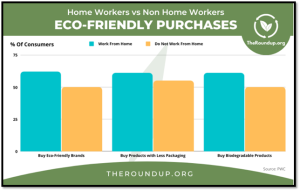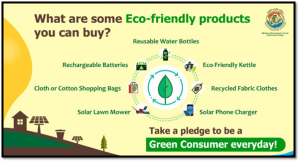GREEN CONSUMER DAY
By Alyssa Jairam

1.0 SUMMARY
Green Consumer Day is celebrated annually on 28th September and aims to bring awareness to the importance of recycling, reusing and reducing waste materials. On this day, problems of consumerism and its impact on the environment are highlighted globally and persons are educated on how small actions can either help or harm our planet, Earth. This research paper focuses on understanding green consumerism with the aim of educating persons about green consumers, the green concept of sustainability, green consumer segmentation and individual’s attitudes toward sustainability and environmentally conscious purchases. The paper also discusses benefits associated with green consumerism and concludes with the various ways whereby persons can become a Green Consumer through activities in their everyday lives.
2.0 INTRODUCTION
A Green Consumer refers to a person who purchases items that have been produced in a way that protects the natural environment (Cambridge, 2023). Green consumers achieve this by purchasing eco-friendly items, products that contain little or no packaging, products that are created from natural resources or products that were manufactured without causing pollution or use the least amount of energy during production and operation (Shukla, 2023).
Green consumerism is also known as ‘Ecologically Conscious Consumption’ and is a state whereby consumer-demand products have undergone an eco-friendly production process or one that involves recycling and safeguarding the planets’ resources. Green consumerism emerged around the 1980’s and focuses on the production, promotion and advancement of the use of goods and services based on their pro-environmental benefits (Kukreja, 2023). The practice of green consumerism demonstrates one’s commitment to the environment and society by purchasing and consuming eco-friendly items, even if that means paying a higher price for the items.
The green concept of sustainability is commonly referred to as ‘Going Green’ and involves environmentally friendly decisions to reduce, reuse and recycle. ‘Going Green’ means that an individual has implemented certain lifestyle changes in his/her everyday life that is geared toward living in a more eco-friendly way by becoming more environmentally aware and changing one’s habits and behaviour to reduce the amount of waste and pollution generated (College of the Canyons, 2023).
At present, due to the increase in the global human population which is expected to increase to 9.7 billion by 2050 (United Nations, 2023), the demand for products and with individuals having a busier lifestyle, persons often purchase products that are more convenient and easily accessible as compared to products that are more environmentally-friendly since they do not have the time to research products before making a purchase. As such, the topic of Green Consumerism was chosen because anthropogenic activities and decisions are impacting the environment negatively and contributing to Climate Change. Also, due to rapid economic growth, environmental degradation is increasing however, individuals can implement small changes in their daily lives which can reduce the negative effects on the environment and make a positive difference for the future generations. One such example is by becoming a Green Consumer and living sustainably.
3.0 PAPER OBJECTIVES
The objectives of this paper are:
- To define the term ‘Green Consumer.’
- To understand Green Consumerism.
- To educate persons on the Green Concept of Sustainability.
- To bring awareness of Green Consumption and Green Consumer Segmentation.
- To show the global attitudes of persons towards sustainability and when making environmentally conscious purchases.
- To educate persons on the benefits associated with green consumerism.
- To show how persons can become a green consumer using activities in their everyday lives.
4.0 APPLICATION OF THEORY
4.1 Green Consumption
Green consumption is associated with sustainable consumer behaviour as it safeguards the environment for both the present and future generations. This is achieved by attributing consumers responsibility in order to address environmental problems through the adoption of environmentally friendly behaviours such as using organic products, implementing renewable energy and choosing goods/products that have zero (or almost zero) impact on the environment when produced.
In order to produce goods/products with zero (or almost zero) impact on the environment, persons/companies can utilize various strategies. Some of these include:
- Zero Wastage – This refers to a set of principles that focus on waste prevention and encourages the redesigning of the life cycle of resources with the aim of having all products repurposed or upcycled and reused. Zero wastage prevents trash from being dumped in landfills, incinerators and the ocean. At present, approximately 7 billion tonnes of plastic waste are generated globally however, less than 10% is recycled (United Nations Environment Programme, 2023). Therefore, in a Zero Waste System, all materials are reused until the optimum level of consumption is achieved.

Figure 1: The 5 R’s of Zero Waste.
Source: sarahbassett.co
- Zero Emission Vehicles (ZEVs) – These are automobiles that do not emit exhaust gas or other pollutants into the atmosphere. All electric vehicles are considered to be ‘Zero Emission Vehicles’ since they do not produce any direct exhaust or tailpipe emissions (Alternative Fuels Data Center, 2023).

Figure 2: Conventional vs Zero Emission Vehicles. Source: rac.com
- Zero Energy Buildings (ZEBs) – These are also known as Net Zero Energy (NZE) buildings and refer to any infrastructure with net zero energy consumption, that is, the total amount of energy utilized by the building on a yearly basis is equivalent to the amount of renewable energy created on-site or by renewable energy sources off-site. In order to achieve this, various technologies are used on these buildings such as solar panels, heat pumps, high efficiency windows and insulation. ZEBs aim to reduce the overall greenhouse gas emissions into the atmosphere and are encouraged due to the reduced environmental impact. Additionally, ZEBs are financially viable since persons are awarded tax breaks as well as savings on energy costs.

Figure 3: Features of a Net Zero Energy (NZE) Building. Source: buildteam.com
4.2 Green Consumer Segmentation
When it comes to purchasing products, not all buyers are the same. As such, the term ‘Green Consumer Segmentation’ was introduced as it provides a better outlook on the perceptions and attitudes of consumers towards environmental sustainability.
Consumers can be divided into four distinct buyer segments which are as follows (Kodali, 2023):
- Active Greens – These are the most environmentally conscious consumers who are willing to pay a premium or an additional fee for items that are eco-friendly as they consider the product’s impact on the environment.
- Convenient Greens – These are consumers that are environmentally conscious, but they value convenience over the environmental impact of products (in most cases). Persons who are considered to be ‘Convenient Green Buyers’ are usually busy and price-conscious, for example, parents of a young family.
- Dormant Greens – These consumers are not actively looking for environmental information or sustainable products but can be persuaded. For example, if the price is within their range, they may select an environmentally friendly product.
- Non-Greens – These consumers mainly focus on cost and are least concerned about the impact of climate change on society. Non-Green consumers are those who will not actively make any type of trade-off for the environment.
5.0 GLOBAL STATISTICS

Figure 4: Global attitudes towards sustainability for the period 2021. Source: TheRoundup.org
As seen in Figure 4 above, the attitudes from consumers globally regarding sustainability are changing. According to a 2021 study, 68% of persons globally now utilize their own shopping bags, 59% recycle their waste regularly, 51% avoid products that they know are harmful for the environment, 47% avoid single-use plastic and 40% of the global population purchase organic or natural products. This statistic was chosen as it shows that consumers are becoming more willing in purchasing and using less in an attempt to reduce their impact on the environment. Additionally, 68% of global consumers have indicated that they are willing to reduce their consumption by half to avoid environmental damage and/or climate change. When this data was analyzed by region, the willingness was higher in Africa and the Middle East (78%) and lowest in North America (58%).

Figure 5: Home Workers vs Non-Home Workers Eco-Friendly Purchases. Source: TheRoundup.org
As seen on Figure 5 above, 62% of home workers purchase products from companies and brands that support the protection of the environment as compared to 50% who do not work from home. In terms of buying products with eco-friendly or less packaging, 61% of home workers engage in this activity whereas 55% do not. Additionally, 61% of home workers purchase more biodegradable or eco-friendly products as opposed to 50% who do not work from home. This statistic was chosen as it shows that consumers who primarily work from home may have more spare time and can better research and reflect on products before purchasing them as compared to persons who do not have that extra time since they do not work from home.
6.0 DISCUSSION
6.1 Benefits of Green Consumerism
Green consumerism involves the production, promotion and advancement of the use of goods and services based on their pro-environmental benefits. In the modern era, persons are becoming more aware of the processes involved for the production of various products and are being encouraged to purchase or use products that do not harm the environment.
Some benefits of green consumerism include (Kukreja, 2023):
- Reduced Waste – Green consumerism advocates for frugal packaging options as persons can purchase loose products like fruits and vegetables instead of pre-packaged products. Additionally, green consumerism encourages the reuse of paper and plastic packaging bags and tins which cause environmental degradation.
- Increased Energy Efficiency – Green consumerism also advocates for the efficient use of energy which helps to save money, reduce utility bills, lower emissions of greenhouse gases and allows economies to meet the increasing energy demands.
- Reduced Emissions and Pollutants into the Atmosphere – Green consumerism reduces emissions from the industrial and transportation sectors due to advocacies, programs and standards that are against the emission of pollutants into the atmosphere. Green consumerism therefore lowers emissions from engines and motors and encourages the advancement of clean-burning fuels.
- Consumption of Healthier Foods – Through green consumerism advocacies, there has been an increase in the need for more eco-friendly food production. As a result, persons are gradually developing a culture of buying more local and organic foods which are healthier since these are not cultivated or produced using artificial chemical fertilizers, antibiotics, hormones or pesticides.
6.2 How to Become a Green Consumer
In future years, people will realize how beneficial it would have been to conserve our planet. In order to avoid regrets into the future we can begin to conserve our natural environment and its resources by becoming green consumers.
The following are possible ways to become a green consumer:
- Reduce your energy consumption by switching off lights and other power sources when they are not in use. This can be practiced at home as well as at our workplaces. Persons can also develop a habit of sitting in a single room daily rather than having each person in a different room which will utilize many sources of electricity to operate different lighting and appliances in the different rooms of the same building.
- Utilize solar energy technologies. Solar products such as solar water heaters and solar lights rely on the Sun’s energy instead of electricity for operating which will therefore prevent environmental depletion. However, while these products may cost more than traditional products, they are more environmentally-friendly and will last longer as they utilize natural energy.
- Check energy labels on appliances before making a purchase as some appliances that are not energy efficient can consume too much energy. For example, when purchasing items like refrigerators and air-conditioners, you should ensure that it has an ‘Energy Star’ label as it shows the product meets strict guidelines for energy saving that was set by the EPA.
- Recycle and reuse eco-friendly products. For example, instead of buying bottled water, you can purchase a water bottle that you can reuse. This activity will also reduce the amount of plastic bottles that are disposed of globally which find their way into the Sea and can harm marine life. Additionally, instead of using paper towels or napkins, you can use a cloth which you can wash and reuse many times.
- Purchase foods like fruits and vegetables that are organic and grown locally since it contributes to lowering the effects of carbon emissions during transportation and the effect of artificial pesticide or fertilizer use on the environment.
- Invest in a hybrid vehicle as these use less fuel. Hybrid vehicles also reduce carbon emissions into the environment which contribute to climate change and global warming and result in habitat destruction and the loss of biodiversity.
- Change your mindset. While it can be difficult to force persons to use products or services that prevents depletion of natural resources which can result in habitat loss and environmental degradation, we can however change their mindset as it pertains to green conservation by educating persons on the dangers and impact of environmental degradation.

Figure 6: Eco-friendly products that persons can purchase to become a green consumer.
Source: theearthview.in
7.0 CONCLUSION
Green Consumer Day brings awareness of the problems associated with consumerism and its impact on the environment while educating persons on the importance of recycling, reusing and reducing waste. Green consumption safeguards the environment for the present and future generations through sustainable practices however, consumers are divided into four (4) buyer segments based on their perceptions and attitudes. Globally, consumers are gradually becoming more willing in using products that help to reduce their impact on the environment and 68% of global consumers have indicated their willingness to reduce their consumption by half to avoid environmental damage and/or climate change. Finally, there are various ways whereby persons can become a green consumer and live a sustainable life through eco-friendly decisions in their everyday lives.
References
- “All-Electric Vehicles.” 2023. Retrieved from Alternative Fuels Data Center (AFDC): https://afdc.energy.gov/vehicles/electric_basics_ev.html#
- Bassette, Sarah. 2021. “Zero Waste Living: How To Live Zero Waste.” Retrieved from: https://sarahbassett.co/zero-waste-living-how-to-live-zero-waste-or-close-to-it/
- Darby, Ashanti. 2023. “Defining Net Zero Energy Housing.” Retrieved from BuildTeam.com: https://www.buildteam.com/blog/net-zero-energy-housing/
- “Green Consumer.” 2023. Retrieved from Cambridge University: https://dictionary.cambridge.org/dictionary/english/green-consumer
- “Green Consumer Day.” 2023. Retrieved from Department of Environment and Climate Change: https://envt.kerala.gov.in/events/event/world-maritime-day-green-consumer-day-september-28/#
- “Green Sustainability.” 2021. Retrieved from Professional Evaluation and Certification Board (PECB): https://pecb.com/article/green-sustainability#
- Kadali, Sucharita. 2023. Retrieved from Forrester: https://www.forrester.com/what-it-means/ep312-green-consumer-segmentation/
- Kukreja, Rinkesh. 2023. “Green Consumerism: Importance, Examples and Strategies.” Retrieved from Conserve Energy Future: https://www.conserve-energy-future.com/green-consumerism-importance-examples-strategies.php
- “Low and Zero Emission Vehicles.” 2023. Retrieved from RAC.com: https://rac.com.au/about-rac/advocating-change/low-and-zero-emission-vehicles
- “Population.” 2023. Retrieved from United Nations: https://www.un.org/en/global-issues/population#
- Ruiz, Arabella. 2023. “51 Huge Environmentally Conscious Consumer Statistics.” Retrieved from TheRoundUp.org: https://theroundup.org/environmentally-conscious-consumer-statistics/#
- Shukla, Utkarsh. 2023. “Green Consumer: Definition And Meaning.” Retrieved from TutorialsPoint: https://www.tutorialspoint.com/green-consumer-definition-and-meaning#
- “What Does Going Green Mean?” 2023. Retrieved from College of the Canyons: https://www.canyons.edu/administration/committees/sceec/resources/information/going-green.php
- “World Green Consumer Day Is Here For A More Sustainable Shopping List!” 2021. Retrieved from The Earth View: https://www.theearthview.in/world-green-consumer-day-is-here-for-a-more-sustainable-shopping-list/
